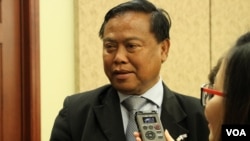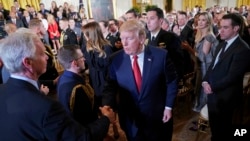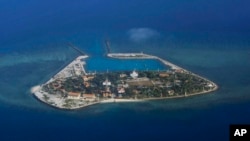Conflict in the South China Sea and regional economic development are the two biggest, and intertwined, issues facing leaders of the Association of Southeast Asian Nations (ASEAN) when they meet in two weeks in Manila as the regional bloc celebrates its 50th anniversary.
Five member nations ---Brunei, Indonesia, Malaysia, Philippines, and Vietnam ---have territorial claims in the South China Sea, 90 percent of which is claimed by China. Cambodia, another member, backs China and has objected to any attempt to magnify the issue in line with ASEAN’s preference for consensus building over discord.
Those nations and the other members---Myanmar, Thailand, Laos, Singapore---have used consensus to develop the bloc into what “one of the success stories of modern economics,” according to the World Economic Forum. “In 2014, the region was the seventh-largest economic power in the world. It was also the third-largest economy in Asia, with a combined GDP of US$2.6 trillion” and an annual growth between four and five percent.
The Manila meet-up takes place after the inaugural year of the ASEAN Economic Community (AEC), which “envisions ASEAN as a single market and production base, … with equitable economic development, and fully integrated into the global economy,” according to the official website. “With harmonized trade and investment laws, ASEAN, as a rules-based organization will be strengthened and become more interesting as a single investment destination.”
“We see that the power struggle makes some ASEAN countries lose their balance,” said Chheang Vannarith, a researcher at the Iseas-Yusof Ishak Institute, a Singapore think-tank focused on Southeast Asia. “If the U.S. and China continue to compete for power in the region, it can affect ASEAN unity.”
And that unity has benefitted ASEAN’s member nations, he said. “We see that the economic integration is in-depth, especially in the last 20 years after the end of the Cold War,” said Chheang Vannarith. “Since the early 1990s until now we’ve seen that the economic integration is deep and dynamic. In the future, the economic dependency will be very crucial to achieve ASEAN community.”
Troubled waters
Tensions in the South China Sea have been mounting since 2010 when China boosted its presence in the 3.5 million-square-kilometers rich in fish and fuel reserves. The exclusive economic zones of ASEAN members Brunei, Malaysia, Vietnam and the Philippines overlap with China’s claims.
Territorial disputes over the South China Sea extend beyond each nation's exclusive economic zone, which is internationally accepted to be no more than 200 nautical miles from shore.
In 2016, four years after China occupied a shoal, the Permanent Court of Arbitration in The Hague ruled in favor of the Philippines, when it concluded China has no legal basis for its claim of historic rights in much of the disputed waters. Chinese President Xi Jinping rejected the decision.
The issue has the potential to hang over the region for years, especially in negotiating an effective code of conduct for the waters, said Bonnie Glaser, a Washington-based China and Asia specialist with the Center for Strategic and International Studies (CSIS).
Years of negotiations have produced non-binding framework code which members adopted in August, a code which the United States, Japan and Australia want to see become "legally binding, meaningful, effective, and consistent with international law."
“So that clearly means that this will not move any faster than China wants it to move,” Bonnie Glaser told a CSIS gathering in mid-October. “And that everybody has, I think, agreed to that.”
Cambodian Ambassador to the U.S. Chum Bunrong said that the involvement of non-ASEAN powers in the region won’t lead to bickering among the member nations.
“ASEAN members understand each other,” Chum Bunrong told VOA Khmer by phone.
The Cambodian government said that ASEAN will remain united in the face of outside pressure because of its “one destiny” platform and “impartial” position toward its partners because “ASEAN uses a peaceful principle that cannot be overlooked,” said Phay Siphan, spokesman for the Council of Ministers. “ASEAN works together to impartially solve the issue through dialogue forum and can reach our solution step by step. This is very important.”
Economic cooperation
Other than China, the biggest non-ASEAN member player in the region is the United States. Washington is marking its 40th year of engagement with the bloc and has recently been focused on four areas, business, policy, energy, and innovation, according to Matt Matthews, the State Department's deputy assistant secretary and ambassador for APEC from the Bureau of East Asian and Pacific Affairs.
He predicts that U.S. involvement with the region will deepen.
“Together with the president’s visit in November, we will be able to reassure folks that we are in the Asia Pacific as an Asia Pacific power and we are here to stay,” Matthews said at a CSIS event in mid-October.
U.S. President Donald Trump is scheduled to attend the Nov. 11-12 APEC annual forum in Vietnam and then travel to the Philippines to take part in ASEAN 50th anniversary celebrations and the annual ASEAN-US Summit Nov 12-13. Media reports this week say Trump will not remain in the Philippines until Nov 14, when the larger annual East Asia Summit is scheduled.
“I think that once the administration gets into the rhythm of what they see in the region, I think they will start to understand why economic and security pillars go hand in hand,” said Ashok Mirpuri, Singapore’s ambassador to the U.S. acknowledging the regional apprehension over rising tensions between North Korea and the United States. “You cannot just do the security pillar without focusing on economic pillar. I think that’s what we’re hoping and able to see in the future.”
According to the U.S. ASEAN Business Council, the total value of the US-ASEAN bilateral trade is at $273 billion. ASEAN's surplus in goods with the U.S. totaled $77 billion in 2015, while the U.S. surplus in services with ASEAN totaled $8 billion.
“We’ve now begun to see greater foreign investment into the United States from the ASEAN region,” said Marc Mealy, vice president for policy of US-ASEAN Business Council.
“We expect over the next 40 years that trend [will] continue … . This will be a real hallmark of the benefit to the United States of this 40th anniversary of diplomatic relation with ASEAN.”
Early days yet
However, Mealy told VOA Khmer by phone that the AEC is still in the “fundamental initiative” and much needs to be done to improve and standardize customs procedures and regional transportation, and harmonize trade in agricultural commodities, food products, and manufactured goods.
Mealy suggested that the AEC has the opportunity to learn from missteps made by other regional bloc such as the European Community, which found when members pooled resources, the economically advanced members benefitted more. He said ASEAN should take care of its lesser developed countries like Cambodia, Laos, and Myanmar so that they are able to fully participate and benefit from AEC.
“The benefit of greater regional economic integration must be able to flow more directly to ASEAN’s less-developed countries,” said Mealy, “and not only to ASEAN’s more developed countries.”




